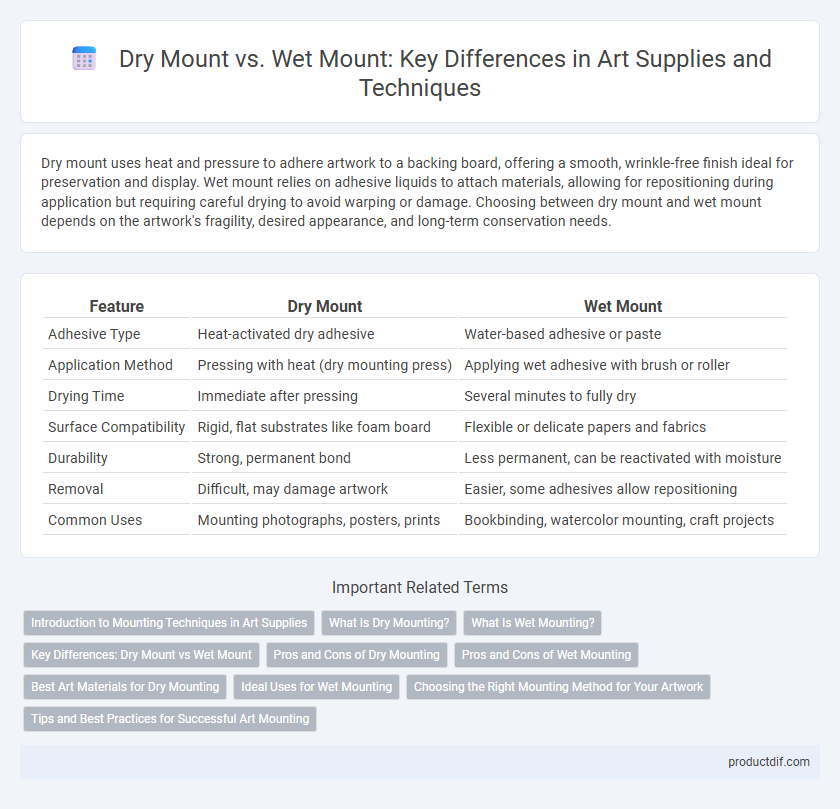Dry mount uses heat and pressure to adhere artwork to a backing board, offering a smooth, wrinkle-free finish ideal for preservation and display. Wet mount relies on adhesive liquids to attach materials, allowing for repositioning during application but requiring careful drying to avoid warping or damage. Choosing between dry mount and wet mount depends on the artwork's fragility, desired appearance, and long-term conservation needs.
Table of Comparison
| Feature | Dry Mount | Wet Mount |
|---|---|---|
| Adhesive Type | Heat-activated dry adhesive | Water-based adhesive or paste |
| Application Method | Pressing with heat (dry mounting press) | Applying wet adhesive with brush or roller |
| Drying Time | Immediate after pressing | Several minutes to fully dry |
| Surface Compatibility | Rigid, flat substrates like foam board | Flexible or delicate papers and fabrics |
| Durability | Strong, permanent bond | Less permanent, can be reactivated with moisture |
| Removal | Difficult, may damage artwork | Easier, some adhesives allow repositioning |
| Common Uses | Mounting photographs, posters, prints | Bookbinding, watercolor mounting, craft projects |
Introduction to Mounting Techniques in Art Supplies
Dry mount uses a heat-activated adhesive to bond artwork quickly and securely to a backing board, preserving the piece without moisture exposure. Wet mount involves applying a water-based adhesive, allowing for repositioning and a strong bond once dried, ideal for delicate papers and textiles. Both techniques are essential in art preservation and presentation, with dry mount offering durability and wet mount providing flexibility depending on the artwork's requirements.
What Is Dry Mounting?
Dry mounting is a technique used in art and framing to adhere artwork or photographs to a rigid backing using heat-activated adhesive sheets. This process provides a smooth, flat finish that prevents warping and adds durability without the risk of moisture damage seen in wet mounting. Artists and framers prefer dry mounting for its clean application and long-lasting support, especially for delicate or valuable pieces.
What Is Wet Mounting?
Wet mounting is a technique used in art preservation and framing where the artwork or photograph is attached to a backing using a moisture-based adhesive or mounting tissue. This method allows for precise positioning and reduces the risk of bubbles or wrinkles, maintaining the integrity and appearance of delicate materials like paper or fabric. Wet mounting is preferred for archival-quality projects because it provides a stable, long-lasting bond that prevents shifting and warping over time.
Key Differences: Dry Mount vs Wet Mount
Dry mount uses heat and pressure to adhere artwork to a backing board, providing a smooth, flat finish ideal for posters and photographs. Wet mount involves a water-activated adhesive that allows repositioning before drying, making it suitable for delicate or archival materials. Key differences include application method, permanence, and suitability for various art mediums, with dry mount offering immediate bonding and wet mount enabling careful adjustment.
Pros and Cons of Dry Mounting
Dry mounting offers a quick and clean method for affixing artwork to backing boards, providing a smooth, bubble-free finish ideal for framing. It avoids moisture, reducing the risk of paper warping or color bleeding commonly associated with wet mounting techniques. However, dry mounting is less reversible than wet mounting, which can limit future restoration options for valuable or delicate art pieces.
Pros and Cons of Wet Mounting
Wet mounting offers enhanced clarity and vibrancy for artwork by using a liquid adhesive that minimizes air bubbles and preserves fine details. This method provides a strong bond, ensuring long-lasting protection, but it carries a risk of moisture damage or warping, especially with delicate paper or fabric materials. Compared to dry mounting, wet mounting requires more careful handling and longer drying times to avoid potential misalignment or adhesive seepage.
Best Art Materials for Dry Mounting
Dry mounting uses heat-activated adhesive sheets to securely bond artwork to a backing surface, making it ideal for preserving fragile prints, photographs, and posters without moisture damage. The best art materials for dry mounting include archival-quality, acid-free mounting tissue or film and a dedicated dry mount press that ensures even heat and pressure distribution to prevent warping. Using these materials guarantees long-lasting preservation while maintaining the artwork's integrity and vibrant appearance.
Ideal Uses for Wet Mounting
Wet mounting is ideal for preserving delicate artworks such as botanical prints, historical documents, and watercolor paintings, where maintaining the original texture and appearance is crucial. This technique prevents the introduction of adhesives directly onto the artwork, reducing the risk of damage and discoloration over time. Wet mounting also allows for slight adjustments during placement, making it suitable for fine art displays requiring precision and archival-quality presentation.
Choosing the Right Mounting Method for Your Artwork
Dry mount offers a fast, adhesive-based bonding method ideal for lightweight prints and delicate papers, providing a smooth, wrinkle-free finish. Wet mount involves a controlled application of water or adhesive solutions, enhancing durability for heavier, mixed-media artwork or archival-quality pieces. Selecting the appropriate mounting technique ensures preservation of art integrity, longevity, and aesthetic presentation tailored to specific material needs.
Tips and Best Practices for Successful Art Mounting
Use a dry mount press to achieve smooth, bubble-free adhesion for posters and prints, ensuring consistent heat and pressure for optimal results. When wet mounting, apply a thin, even layer of archival-quality adhesive with a foam brush to prevent warping and wrinkles in delicate papers. Always allow the mounted artwork to dry under a weight or in a press to maintain flatness and longevity.
Dry Mount vs Wet Mount Infographic

 productdif.com
productdif.com